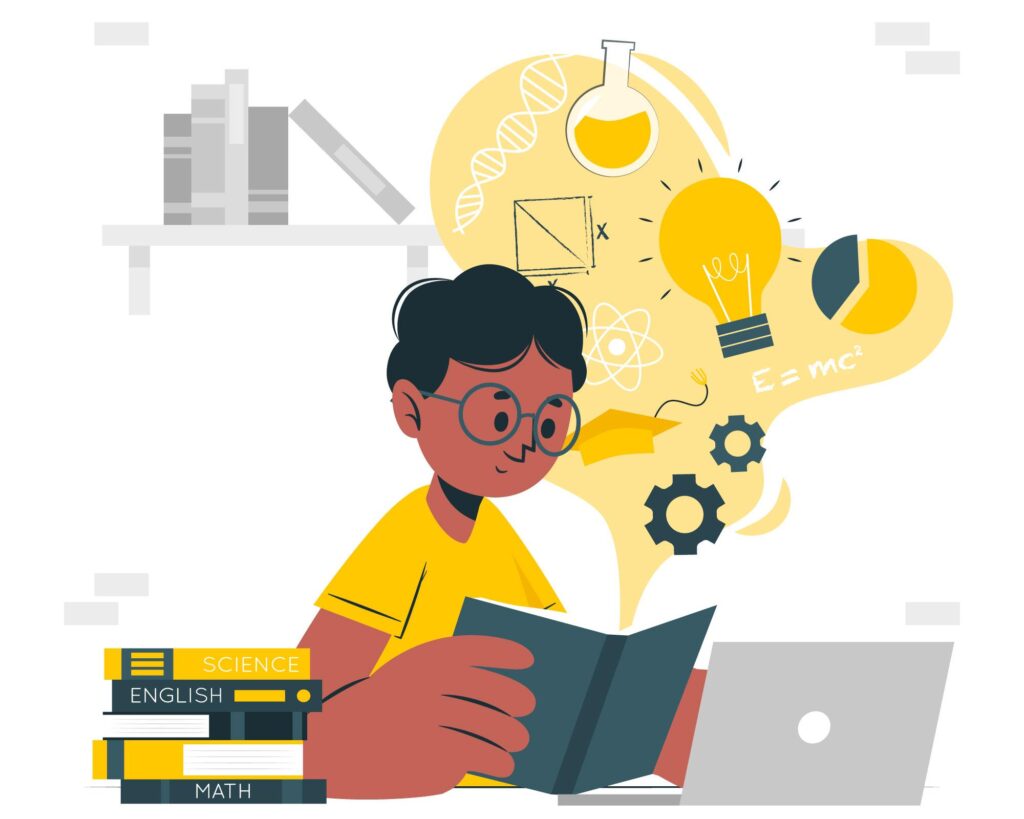Choosing the right study techniques is an important element of the learning process that too many students overlook. The study techniques can help students achieve their full potential, whereas a poorly chosen study technique will sabotage any actual development, no matter how hard the student studies.
If you’re reading this guide, you’re probably an exception, but the truth is that most students use inefficient study techniques. Researchers discovered that between 83.6% and 84% of students rely on rereading—a study strategy with negligible benefits.
There are significantly more effective study approaches than rereading. Methods created and researched by the world’s leading learning scientists.
However, shockingly few students have heard of them. That is why using them correctly will give you not merely an edge but a complete advantage over the competition.
6 Study Techniques for Students

1. Active Recall
This study technique entails testing yourself on the content you’ve studied rather than simply rereading it. Flashcards, practice questions, and quizzes are all examples of active recall strategies. By actively engaging with the content, you will be able to discover areas where you should concentrate your efforts and increase your grasp of the topics.
2. Interleaving
Interleaving is another study technique that can be useful for students. This entails alternating between different topics or sorts of tasks during a study session. For example, if you’re studying for a history exam, you could alternate between studying various historical events rather than focusing solely on one topic. This strategy strengthens links between distinct types of knowledge and improves retention.
3. Elaboration
Elaboration is another approach that can help you retain information. This entails building on what you’ve learned by creating connections with other knowledge, asking questions, and expressing concepts in your own words. By expanding on what you’ve learned, you’ll be able to better understand and retain the information.
4. Using Visual Aids
Visual aids can also be an effective study strategy. Diagrams, mind maps, and graphs can all help you learn and retain complex information. These visual aids can assist you in organizing information in a way that is understandable to you and identifying crucial connections between various pieces of information.
5. Teaching others
If you can find someone who is eager to listen and learn, teaching them what you know might be a great way to advance your studies. Explaining topics to others allows you to identify areas where you need to focus your attention while also reinforcing your own grasp of the material.
6. Look after yourself
While this isn’t a study technique, it’s nevertheless important to maintain your physical and mental well-being. Getting proper sleep and exercise can greatly improve your ability to learn and retain information. Take pauses as needed, and don’t be hesitant to seek assistance if you’re having difficulty with a specific subject.
There are several excellent study techniques available to assist you in improving your academic performance. By experimenting with different strategies and determining what works best for you, you may maximize your study time and attain your academic objectives.
The 6 Types of Study Techniques by Researchers
1. Spaced Repetition
There are several excellent study approaches available to assist you in improving your academic performance. By experimenting with different strategies and determining what works best for you, you may maximize your study time and attain your academic objectives.
- Session 1: Day 1
- Session 2: Day 7
- Session 3: Day 16
- Session 4: Day 35
- Exam Date: Day 36
In a nutshell, it’s the direct opposite of studying and staying up all night. Instead of cramming all of your studying into a short period of time, this strategy asks you to spread it out by reviewing and recalling knowledge at ideal intervals until the material is memorized.
2. The Pomodoro Study Method
The Pomodoro study method is a time-management approach that involves using a timer to divide your study time into 25-minute (or 45-minute) increments known as Pomodoro sessions. Then, after each session, you’ll take a 5-minute (or 15-minute) break to completely disengage from the study topic. After completing four such sessions, you’ll take a longer 15- to 30-minute break.
To attempt the Pomodoro technique without installing any software or purchasing a timer, I recommend going to YouTube. YouTube is flooded with Pomodoro-based “study with me” videos from channels like TheStrive Studies, Ali Abdaal, and MDprospect.
Many of them, however, include music, so if music distracts you when studying, you may benefit from purpose-built Pomodoro software like TomatoTimer or RescueTime.
There are several advantages to using the Pomodoro method:
- It is a simple and straightforward technique.
- It forces you to map out your daily tasks and activities.
- It allows for easy tracking of the amount of time spent on each task, and it provides short bursts of concentrated work followed by rest periods.
However, it is worth emphasizing that the scientific evidence for the Pomodoro method is primarily conjectural, as there has been little scientific investigation into its usefulness.
3. Feynman Technique
Richard Feynman, a Nobel Prize-winning physicist, devised the Feynman Technique, which is a flexible, simple, and successful study technique. It is built on a simple concept: the best method to learn any topic is to teach it to a sixth-grade child.
While this notion is not as advanced as the super-optimized spaced repetition algorithms, it remains a useful method over a century later. The Feynman Technique is an effective learning tool that forces students to move beyond their comfort zone by breaking down even the most complicated topics into manageable bits. It is digestible enough for the typical sixth-grade student.
This may seem like a simple process at first. How difficult may it be to explain something to a child? In practice, it can be extremely tough because you must simplify and explain everything in an age-appropriate manner.
When you first use the method, you’ll notice that reaching a child at their level of knowledge is difficult unless you’ve completely grasped the subject.
To explain something clearly, you must define all unknown words, provide basic explanations for complicated ideas, comprehend the relationships between different topics and sub-topics, and convey what you have learned clearly and eloquently. The Feynman Technique challenges you to learn more thoroughly and critically about what you’re learning, which is why it’s such an effective learning strategy.
4. Leitner System
The Leitner System is a straightforward and successful study technique that uses a flashcard-based learning mechanism to maximize memorization. It was created by Sebastian Leitner in 1972, and it served as an inspiration for many of the later flashcard-based approaches that followed, including Anki.
To use the strategy, first build flashcards. The questions will be written on the front of the cards, followed by the answers on the backs. Then, once you’ve finished making your flashcards, purchase three “Leitner boxes” large enough to accommodate all of them. Let’s call them Boxes 1, 2, and 3.
Now you’re ready to start studying with your flashcards. Initially, you will place all cards in Box 1. Take a card from Box 1 and attempt to recall the answer from memory. If you recall the solution, enter it in Box 2. If not, store it in Box 1. Then, continue until you’ve gone through all of the cards in Box 1 at least once. Following that, you’ll begin reviewing each box of cards according to time intervals.
5. The PQ4R Study Method
The PQ4R is a research approach developed by Thomas and Robinson in 1972, the same year the Leitner System was conceived. PQ4R refers to the stages taken to learn anything new: preview, question, read, reflect, recite, and review. It is widely used to increase reading comprehension and is a crucial tool for students with reading impairments.
However, PQ4R’s value is not limited to students with reading impairments. The same six actions can be taken by every student who wants to better understand what they’re reading.
Improving reading comprehension is an admirable objective for any student, and if you need to read through a large textbook for an exam, the PQ4R method provides a useful foundation. It will help you understand all of the text’s portions and retain knowledge more effectively.
We can improve our reading comprehension by combining knowledge and interpreting language more effectively. However, we must be careful not to allow this method to take up too much of our study time.
Many modern learning scientists believe that reading is a passive and poor study strategy and that it is preferable to use other strategies whenever possible.
6. SQ3R Study Method
Francis P. Robinson devised the SQ3R study method in 1946, which is the forerunner to the PQ4R method. It’s a time-tested study strategy that can be used for almost any subject. The method’s name stands for Survey, Question, Read, Recite, and Review, and it may be used to study anything more quickly, effectively, and structurally than traditional approaches.
While innovative at the time, the SQ3R research approach shares the same limitations as the subsequent PQ4R method. For starters, it’s mostly employed to improve reading comprehension, and reading is no longer considered an effective study approach.
The method also lacks the “reflection” component included by the newer PQ4R research method. Furthermore, three of the method’s five processes (surveying, reading, and reviewing) use a passive rather than active approach.
According to modern learning theories, active retrieval outperforms passive reading in terms of information retention. As a result, I advocate adopting this study method only when you don’t have enough time to employ a more robust method, such as spaced repetition.
SQ3R is most effective when you have limited study time and rely mostly on a textbook for knowledge. In such instances, the technique can be extremely useful for summarizing the essential points mentioned in the original material.
Conclusion
Finally, as a student in the twenty-first century, you have access to a wide range of good study methods. The best one for you will be determined by your learning style, the content you are studying, and the amount of time you have available. When possible, I propose combining spaced repetition, active recall, and the Pomodoro approach. However, the other tactics suggested here are probably useful. Above all, try to remain flexible and open-minded. This will allow you to fully realize your learning potential.


